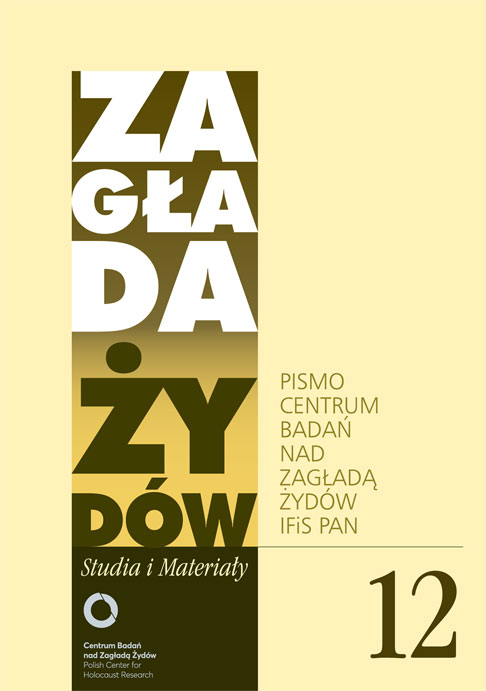Frankenstein w warszawskim getcie. Historia i legenda
Zagłada Żydów. Studia i Materiały, Nr 12 (2016), Strony: 187-208
Data zgłoszenia: 2020-10-19Data publikacji: 2016-11-30
 https://doi.org/10.32927/ZZSiM.414
https://doi.org/10.32927/ZZSiM.414
Abstrakt
The article deals with one exceptionally violent German perpetrator who was part of the occupation force in Warsaw during the Second World War. Inside the Ghetto he maltreated and killed a large number of women, children and men for his own personal pleasure. He did this to such an extensive degree that the population perceived him as monstrous being that was given the nickname „Frankenstein”. The article is mainly based on statements in juridical investigations, from the victim as well as from the perpetrator perspective, supplemented with some selected additional sources. Firstly the source corpus will be evaluated, to work out how these historical sources can be used to shed light on „Frankenstein”. This will be followed by an analysis of the actual identity of this perpetrator. It will be shown that he was, contrary to common belief, not necessarily the SS-Rottenführer Josef Blösche but more likely a member of the German Police Battalion 61. In the end the question will be also raised of how it was possible – despite all rules and regulations – that ghetto guards like him behaved like a marauding soldiery.
Słowa kluczowe
getto warszawskie , Zagłada , policja umundurowana , zbrodnie okupacyjne , warty w getcie , batalion policyjny , sprawca , przemoc , strach , terror , życie w getcie
Licencja
Prawa autorskie (c) 2016 Autor&"Zagłada Żydów. Studia i Materiały"

Utwór dostępny jest na licencji Creative Commons Uznanie autorstwa 4.0 Międzynarodowe.
https://creativecommons.org/licenses/by/4.0
Czasopismo publikowane jest w standardzie Diamond Open Access na licencji CC-BY-4.0 Deed - Uznanie autorstwa 4.0 Międzynarodowa - Creative Commons
Podobne artykuły
- Dariusz Libionka, Apocrypha from the History of the Jewish Military Union and its Authors , Zagłada Żydów. Studia i Materiały: 2008: Holocaust Studies and Materials
- Ewa Koźmińska-Frejlak, „Idę do pieca, ponieważ nie chciałam mu dać siebie”. Akta Sądu Społecznego przy Centralnym Komitecie Żydów w Polsce. Próba lektury genderowej , Zagłada Żydów. Studia i Materiały: Nr 19 (2023)
- Monika Polit, The Text Called Szmul Rozensztajn’s Diary , Zagłada Żydów. Studia i Materiały: 2008: Holocaust Studies and Materials
- Łukasz Biedka, Blondyn o wyglądzie niezbyt semickim , Zagłada Żydów. Studia i Materiały: Nr 3 (2007)
- Krzysztof Bielawski, „Nawet umarłym nie dali spokoju”. Destrukcja cmentarzy żydowskich na terenach obecnej Polski w latach 1933–1945 , Zagłada Żydów. Studia i Materiały: Nr 15 (2019)
- Tadeusz Bartoś, Zapomnieć , Zagłada Żydów. Studia i Materiały: Nr 11 (2015)
- Marta Grudzińska, Rutka Goldman, Szkolny pamiętnik , Zagłada Żydów. Studia i Materiały: Nr 19 (2023)
- Łukasz Krzyżanowski, „To było między pierwszą a drugą”. Zabójstwo Róży Berger podczas pogromu w Krakowie 11 sierpnia 1945 r. , Zagłada Żydów. Studia i Materiały: Nr 15 (2019)
- Jacek Leociak, Censorship Keeping Guard over the Church. Krystyna Modrzewska’s Censored Memoir , Zagłada Żydów. Studia i Materiały: 2010: Holocaust Studies and Materials
- Jacek Leociak, Redakcja Czasopisma, Dyskurs o pomocy , Zagłada Żydów. Studia i Materiały: Nr 4 (2008)
<< < 1 2 3 4 5 6 7 8 9 10 11 12 13 14 15 16 17 18 19 20 21 22 23 24 25 26 27 28 29 30 31 32 33 34 35 36 37 38 39 40 41 42 43 44 45 46 47 48 49 50 > >>
Możesz również Rozpocznij zaawansowane wyszukiwanie podobieństw dla tego artykułu.
 English
English
 Język Polski
Język Polski




